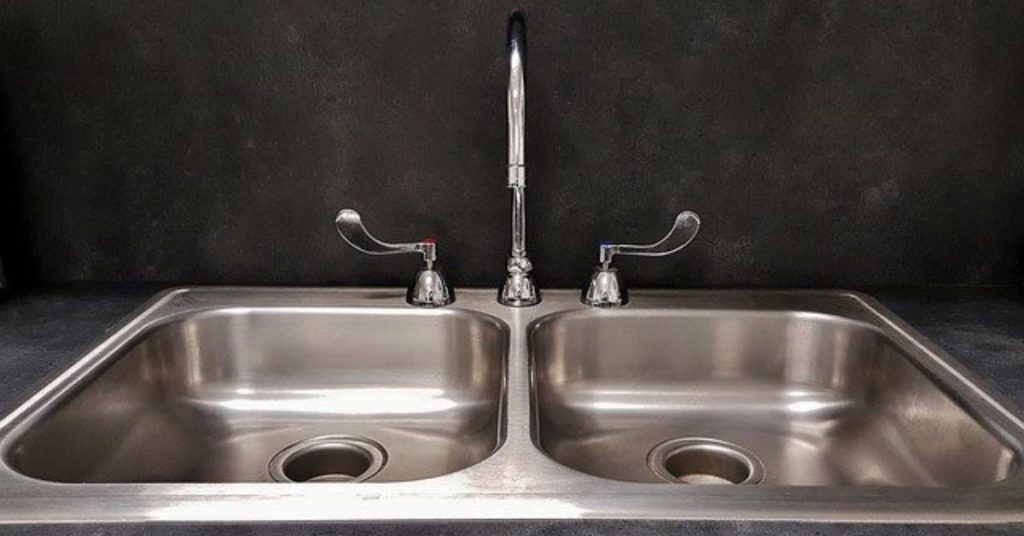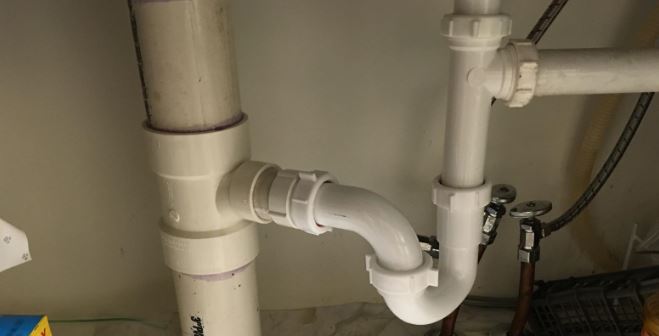
Double kitchen sink backing up into each other is caused by a clog in the main sink drainpipe. To fix the problem, pour half a cup of baking soda and 1 cup of white vinegar down then drain then follow it up with a gallon of boiling water after 15 minutes. Alternatively, remove and clean the P-trap.
Here is a brief summary of this post:
Causes
- Clogged Drainpipe: The most common cause is a clog in the shared drainpipe that both sinks connect to. This blockage can be caused by food debris, grease buildup, or other foreign objects.
- Improper Venting: Inadequate venting in the plumbing system can create airlock issues, disrupting water flow and causing backups.
Solutions
- Use a Plunger:
- Place a plunger over one of the sink drains and ensure a good seal.
- Plunge vigorously to create pressure that can dislodge the clog. You may need to repeat this on both sides.
- Boiling Water:
- Boil a pot of water and carefully pour it down one of the sink drains.
- This can help melt grease and dislodge minor clogs.
- Baking Soda and Vinegar:
- Pour a mixture of baking soda and vinegar down one of the sink drains.
- Let it sit for a few minutes, and then flush with hot water.
- Drain Snake or Auger:
- Use a drain snake or auger to reach deeper into the shared drainpipe and remove the clog.
- Follow the manufacturer’s instructions carefully.
- Check the Venting:
- Inspect your plumbing system’s vent pipes to ensure they are not blocked or obstructed.
- Venting issues may require professional assessment and repairs.
- Professional Help:
- If these DIY methods do not resolve the issue, or if you suspect a more significant problem in your plumbing system, consult a professional plumber for a thorough inspection and repair.
How to Unclog a Double Kitchen Sink Backing Up on Both Sides

The good thing is that unclogging a kitchen sink is quite an easy task and you will rarely need to call a plumber to fix it for you. There are also several ways to do it so you can choose the one you are most comfortable with.
The following are the 3 best ways to unclog a double kitchen sink that backs up to the other side:
1. Plunging

A plunger is a simple but fantastic tool for clearing clogs from drains. You however need to use the right technique if you will want to dislodge the clog easily and fast.
In order to plunge effectively you need to have some standing water inside the sink. You can’t plunge on an empty sink. Its the water that creates the pressure to dislodge the clog.
Since we have established that the clog is in the main sink drainpipe and therefore not specific to any sink bowl, it does not matter which bowl you decide to plunge from. You will however need 2 plungers and an extra pair of hands.
- Have your helper place one plunger over the other sink drain opening and hold it tightly. Failure to do this will mean that the pressure generated by your plunging efforts will escape through the second sink bowl’s drain.
- Place your plunger over the other sink drain opening and make sure that the bottom of the rubber cup is fully immersed in water.
- Start plunging, starting off gently to properly engage the plunger on the sink.
- Plunge aggressively for a couple of minutes without lifting off the plunger.
- Lift the plunger (your helper’s as well) and check if the water will start to drain out easily and that it does not back up through the other side even when your turn on the faucet.
If the sink is draining out properly, you have managed to unclog it. On the other hand, if water continues to back up from the other side of the sink you will need to try something else.
2. Use Baking Soda and Vinegar

Baking soda and vinegar have been used together time and again to unclog drains successfully. Vinegar (a weak acid) and baking soda (an alkali) create a fizzing reaction when mixed together which is what breaks down the clog.
To break the clog even further, dumping a gallon of boiling water also works wonders. As a matter of fact, pouring a gallon of boiling water (or just hot) down your kitchen sink drain even when is not clogged is a fantastic way to prevent clogs.
Here is how to unclog a double kitchen sink using baking soda and vinegar. In this case, I like to use the side of the sink connected to the garbage disposal.
- Remove standing water from the sink. You want the baking soda and vinegar to act on the clog directly. Having standing water in the sink will dilute them lowering their effectiveness. That is why you should start by draining any out standing water from the sink.
- Pour half a cup of baking soda down the drain.
- Slowly add 1 cup of distilled white vinegar. It is important to add the vinegar slowly since it reacts very fast with baking soda.
- To maintain the reaction inside the drainpipe, cover the sink openings and wait for 15 minutes.
- Boil about a gallon of water.
- Dump the boiling water in the sink drain.
- Check how the sink drains.
In most cases, this method is guaranteed to clear a clog from a drain.
3. Remove and Clean the P-trap.
This is a quick and an effective method to unclog a kitchen sink though most people hardly use it. It requires no prior plumbing experience as well.

A P-trap is the U-bend part of your drainpipe underneath your sink. It has 2 main functions:
- Due to its shape, it holds water at all times which acts as a barrier preventing sewer odors from coming up through the sink drain.
- It traps potential drain clogs, preventing them from clogging the drainpipe farther away where unclogging would be more difficult.
If your double kitchen sink is backing up into the other side, there is big chance that the clog is inside the P-trap. Removing and cleaning the P-trap will solve the problem.
Here is how to remove a P-trap and unclog a backing up kitchen sink:
- Start by removing the items you store under the kitchen sink. That will give you enough space to work.
- Place a small container or pan under the P-trap. You do not want to spill the water inside the P-trap on the floor.
- Check the connections. If you carefully look at the P-trap, you will notice that it has a short arm and a long arm. You should start by disconnecting the short arm, so that all the water can flow out via gravity.
- Always check if the connections are hand-tight before reaching out for a wrench, especially if you have a plastic drainpipe.
- Once the connections are loose pull the P-trap down.
- Check if it is clogged. If it is easy drop it in a bucket and clean it thoroughly.
- Check also the pipe connected to the wall. Can you see gunk inside? You can remove the small elbow and try to snake it just to be sure there are no clogs inside.
- Another place you can check for clogs is the tee or drain hose which connects the garbage disposal to the tailpiece (vertical pipe above the P-trap). Clean it as well.
- When you have cleaned the P-trap and removed all the gunk, connect it back and tighten the connections
- Dump a gallon of hot water to flush out any gunk still left in the drainpipe as well as see if the clog has been successfully removed.
The above 3 methods are the best in unclogging kitchen sinks naturally. I would not recommend the use of chemical drain cleaners especially acids or bleach.
How to Prevent a Kitchen Sink from Clogging
One of the best ways to prevent kitchen sink drains from clogging is by avoiding dumping grease down the drain. It does not matter if you will run hot water later. Just don’t do it, but if you accidentally do, check out this post on what to do.
You should also never put egg shells, potato peels, coffee grounds, pasta, oatmeal, nuts, onion skins, pumpkin and basically any food waste rich in starch inside the garbage. These type of waste is responsible for most clogged garbage disposals and/or kitchen sink drains.
As I had already mentioned, pouring hot water in your kitchen sink from time to time will help clear the drain and keep it fully open at all times. A combination of baking soda and vinegar will not only prevent clogs but also get rid of bad smells.
I hope this guide was helpful.
